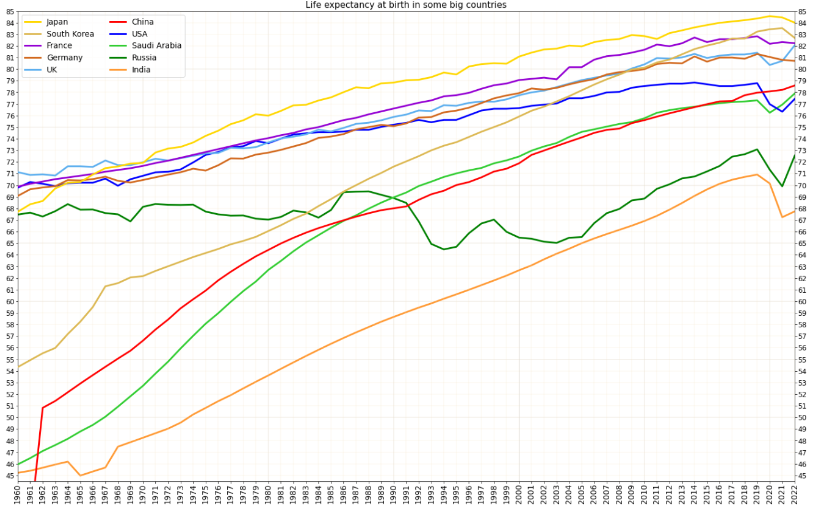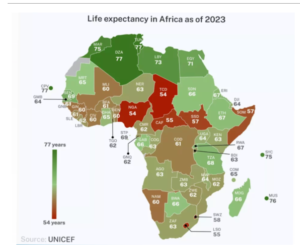Death makes me very angry. Premature death makes me angrier still. Larry Ellison, founder of Oracle (source)
This month’s theme: Recent positive evolutions of life expectancy in the world
Introduction
From 1946 until 2019, at the World level, it could be said that each year was the best time ever to be alive, at least concerning the duration of it. This almost secular trend was broken in 2020, 2021, and maybe 2022. The Covid period it marked the first time since the Second World War with a global decrease in life expectancy. A previous letter exposed the situation known one year ago.
Since 2022, the situation considerably improved especially in Europe and in the USA. We can reasonably think that today is again the best time ever to be alive. However, we have to wait for more data to be sure …. and to hope for the future.
About data concerning life expectancy
What is life expectancy? It is the average period that a person may expect to live. There are various ways to calculate it. Period life expectancy at birth is life expectancy since birth calculated for a given year (or sometimes another period). It is based on the probability of death of each person during this year. So, it uses mortality rates from a single year and assumes that those rates apply throughout the remainder of a person’s life. This means that when there is a high mortality during a given year, the calculated life expectancy will decrease strongly. This means also that any positive or negative future changes to mortality rates are not taken into account.
Life expectancy approached in this letter is measured for countries and by sex. Data concerning life expectancy in good health, life expectancy for various groups, levels of income … are interesting, but not available worldwide and generally less reliable.
We could think that life expectancy is something very easy to measure. The date of birth and the date of death of a person is basic information known precisely to almost everyone. However, there are problems, namely:
- Especially in countries with poor administrative organization, births, and deaths can be not registered; Since in general, a high life expectancy is seen as positive, there can be a trend to exaggerate longevity, especially for very old people.
- People migrating can influence: what if a person is born in one country and dies in another, what about foreigners dying, will they be considered for life expectancy in their country of nationality or residence… ?
- And the biggest difficulty: the slow transmission of data.
Official data are slow to be available. In 2024, available real-life expectancy data still often predates the Covid-times. More recent data are often contradictory. Data you find online for 2022 and 2023 are often actually prospects. For example, data for Kyrgyzstan and Bhutan. This is in a way fascinating and depressing. Not only do we not yet know how to stop aging, we don’t even know how to calculate it globally.
In most countries, an official institution gives information about life expectancy. But to compare at the world level, we have to rely on data coming from international institutions, especially the World Health Organization. The Wikipedia page on life expectancy gives data from 2023 from the United Nations, from 2022 for the World Bank Group and the OECD, and from 2019 for the World Health Organization.
Other good sources are:
Those sources are mostly based on official data, often from the UN.
World analysis of life expectancy by the WHO
The rise in life expectancy was temporarily halted during 2020 and 2021 due to the impact of the COVID-19 pandemic. At the height of the pandemic, global life expectancy at birth fell to 70.9 years, down from 72.6 in 2019. However, since 2022, life expectancy has returned to levels observed before the emergence of COVID-19 in nearly all countries and regions. This recovery marks a return to the positive trend in longevity seen over the past decades.
Globally, life expectancy at birth reached 73.3 years in 2024, an increase of 8.4 years since 1995. Further reductions in mortality are projected to result in an average longevity of around 77.4 years globally by 2054. According to the WHO projections, more than half of all deaths worldwide will occur at age 80 or higher by the late 2050s, compared to 17 percent in 1995.
European situation
In Europe, we live now longer than before the COVID-19 period. In 2023, life expectancy at birth in the EU was 81.5 years, up 0.9 years from 2022 and 0.2 years from the pre-pandemic level in 2019, according to data released by Eurostat on May 3.
This is a very positive evolution and the best progress in one year since many years. This means also that the negative consequences of COVID-19 are finally behind us.
The highest expectancy was recorded in Spain (84.0 years), Italy (83.8 years), and Malta (83.6 years). On the opposite side, the lowest life expectancy at birth is in Bulgaria (75.8 years), Latvia (75.9), and Romania (76.6). In France and Belgium, life expectancy is respectively of 82,7 and 82,3 years.
For Europe, very recent statistics are available. Mortality levels observed by EuroMOMO have been lower than expected throughout spring 2024. So, the positive situation seems to continue.
The situation in North America
US life expectancy began to stagnate specifically in 2012, before declining from 2015 onwards. The impact of COVID-19 in the US was worse than in Europe. This meant that life expectancy in 2021 dropped to the level it was 20 years before, reaching its lowest point since 1996.
Happily, the situation has radically improved in the last few years. In 2022, by gaining 1.1 years between 2021 and 2022, life expectancy at birth reached 77.5 years. In 2023, life expectancy is reported as 79.74 years for both sexes, 82.23 years for women, and 77.27 years for men. The current outlook is much better than at the end of the COVID-19 period, especially for women.
In 2023, the Mexican national statistical agency INEGI reported that the total life expectancy in Mexico was 75.3 years, surpassing the pre-COVID 2019 level by 0.5 years. INEGI forecasts that in 2024, life expectancy in Mexico will continue to rise, predicting it to reach 75.5 years. Detailed life expectancy data for each Mexican state can be found on this Wikipedia page.
In 2022, for the third consecutive year, life expectancy in Canada had declined, marking a historic and concerning trend with a more significant decline among females.
The year 2020 marked a breaking point in Canada’s increasing life expectancy. However, Quebec rebounded quickly, reaching 83 years in 2021, surpassing pre-pandemic levels. Elsewhere in Canada, the decline persisted according to the latest data.
Asia
It is strangely difficult to have precise information about life expectancy in the two largest countries of the world.
In India, the life expectancy for both sexes in 2023 is 72.03 years, with females at 73.65 years and males at 70.52 years. This is supposed to be more than in 2019, but these data are not without questions.
In China, according to data released by the National Health Commission, life expectancy at birth increased from 77.9 years in 2020 to 78.2 years in 2021. By 2023, for some information, life expectancy for both sexes reached 78.79 years, with females at 81.52 years and males at 76.18 years. However, the COVID situation has a negative peak later than in the other countries and the number of deaths in 2023 was rising 6,6 %.
In Japan, life expectancy has been declining in 2021 and 2022 but is probably rising again.
Hong Kong residents no longer hold the record for the world’s longest life expectancies, having ceded this position to Japan as COVID and overall stress impact local lifespans. In 2022, the average life expectancy for women in Hong Kong was 86.8 years, while their Japanese counterparts were expected to live until 87.1 years, according to the latest statistics released by Hong Kong’s government. Data for 2023 and 2024 has not yet been published.
African analysis of life expectancy by the WHO
Before the pandemic, the African region saw substantial gains in life expectancy, with an increase of 11.2 years since 2000.
Life expectancy has been rising again since 2022. As of 2023, the African countries with the highest life expectancies are Algeria, Tunisia, and Cape Verde, each with 77 years, followed closely by Mauritius at 76 years.
In contrast, the countries with the lowest life expectancies in Africa are the Central African Republic and Lesotho, both at 55 years, and Nigeria and Chad, both at 54 years. These disparities highlight the ongoing challenges and varying progress in healthcare across the continent.
The good news of the month: Age-reversal trial with old human volunteers
The company Mitrix Bio plans to begin the first age-reversal trial in human volunteers later this year. The study is first aimed at helping astronauts withstand the high-radiation, microgravity conditions of space, which lead to muscle loss and other complications of premature aging. The company will transplant young, bioreactor-grown mitochondria into a group of volunteers in their 70s and 80s to see if the technique reverses aging.
It is positive that Space Research may help for longevity and that with an experiment made with aged well-informed volunteers.
For more information
- Heales, Longevity Escape Velocity Foundation, International Longevity Alliance, Longecity and Lifespan.io
- Heales Monthly Science News
- Heales YouTube channel
- Source of the graphs: Life expectancy at birth in some big countries (Wikipedia) and Life expectancy in Africa as of 2023 (Unicef)
- Contact us


